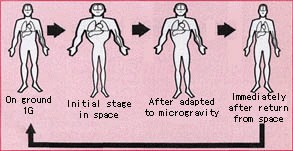The effects of spaceflight on the veins
Purpose
The purpose of the venous compliance experiment was to determine whether spaceflight affects the stretch (compliance, or flexibility) of veins in the lower legs.
Background
Most astronauts experience symptoms such as lightheadedness, nausea, fatigue, and fainting upon standing or sitting upright when they return from a spaceflight. This condition is known as orthostatic intolerance and is caused primarily by cardiovascular deconditioning that can occur in space.
While orthostatic intolerance upon return from space is mainly the result of decreased overall blood volume and the diminishing of the reflexes that normally move blood from the legs to the upper body, venous compliance could play a role in why astronauts experience these symptoms. If spaceflight causes the veins in the lower legs to be more compliant, it would allow more blood to pool in the lower legs upon return to Earth, thus contributing to symptoms of orthostatic intolerance.

Text version
The effects of spaceflight on the veins
Illustration of fluid shifts caused by spaceflight:
- Ground 1G
- Initial stage in space
- After adpated to microgravity
- Immediately after return from space (back on ground 1G)
Fluid shifts caused by spaceflight. (Credit: NASA)
Project description
This investigation was sponsored by the Canadian Space Agency (CSA) and conducted in collaboration with the University of British Columbia, KRUG Life Sciences (Houston, Texas), and NASA's Johnson Space Center Cardiovascular Laboratory on the First International Microgravity Laboratory (IML-1) Mission STS-42, which was launched on January 22, 1992.
During the eight-day flight, three crew members participated as experimental subjects. Two pre-flight, two in-flight, and three post-flight measurements were made on each subject. Venous compliance was calculated by altering lower leg pressure using a compression cuff (similar to a blood pressure cuff) and measuring the lower leg blood volume. Leg volumes were measured using a device called an ultrasonic limb plethysmograph (ULP), which uses an ultrasound pulse to determine leg diameter.

Right: Muscles next to the veins of the legs help force blood back upward toward the heart. (Credit: NASA; from Grey's Anatomy)
Results
During the short-duration mission, calf volume decreased by nine percent after two days, and a further three percent by the sixth day. Most of the reduced volume was regained within a few hours after landing. During flight, the veins in the lower legs were partially collapsed and contained 3 to 4 ml less blood per 100 ml of leg tissue compared to their pre-flight state. In spite of this, venous compliance remained unchanged in-flight and post-flight.